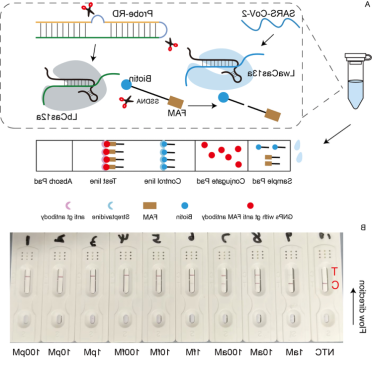Associate Professor Liu Yizhen, School of Chemical and Environmental Engineering, Shenzhen University, in Nature IndexAnalytical Chemistry(Chinese Academy of Sciences category one district,TOP期刊)上发表了题为“From Lab to Home: Ultrasensitive Rapid Detection of SARS-CoV-2 with a Cascade CRISPR/Cas13a-Cas12a System Based Lateral Flow Assay”的研究论文。Full text link:http://pubs.acs.org/doi/10.1021/acs.analchem.4c02726。Associate professorLiu Yizhen andAssociate research fellowChen Yong is the corresponding author, Hu Ronghuan is the first author, and Shenzhen University is the only corresponding author。This research has been strongly supported by the National Key Research and Development Plan of the Ministry of Science and Technology, the Natural Science Foundation of Guangdong Province and the stable support project of Shenzhen Science and Technology Plan。

Innovation background
During the COVID-19 pandemic, home testing has played an important role in public health prevention and control as a quick, convenient and low-cost means of diagnosis。However, commercially available antigen detection kits are prone to false negative results due to insufficient sensitivity.Although RT-PCR is highly sensitive, it requires laboratory environment support and is not suitable for home use。Liu Yizhan's team developed a new detection method that combines CRISPR cascade system and lateral flow immunochromatography analysis, which can achieve high sensitivity SARS-CoV-2 detection under the condition of amplification, solving the shortcomings of existing detection methods。

图1. CLEAR Schematic diagram of the system
Research highlight
1.Innovative detection system CLEAR: This study proposes an amplification free, highly sensitive POC detection method that pretreats nasopharyngeal swab samples using a viral nucleic acid rapid release agent in 3-5 minutes;It is then reacted with CLEAR reagent for 30 minutes to be detected at 33 degrees Celsius。The method displays the results on the paper based test strip, which can realize rapid and intuitive detection。
2.Ultra-high sensitivity and specificity: The CLEAR system can detect novel coronavirus RNA specific sequences within 30 minutes, with a limit of detection (LOD) as low as 1 aM。For CT values less than 34.In 93 clinical samples, CLEAR achieved a 100% positive and negative coincidence rate。This performance greatly improves the possibility and reliability of home testing。
3.Precise typing detection: Through programmed crRNA design, the system can accurately identify single base mutation sites such as K417N, K417T and L452R, and achieve amplification free typing of SARS-CoV-2 variant strains。The results show that CLEAR system has excellent performance in the classification of standard products and clinical samples, and has the potential to be used in the detection of a variety of respiratory pathogens。
4.Convenience and economy: CLEAR system is designed as a home inspection tool, with the characteristics of convenient operation, economy and efficiency。Compared with traditional PCR detection, the method significantly reduces contamination risk and detection time, making it ideal for use in resource-limited environments。

图2. CLEAR system for the classification of clinical samples
Future outlook
This study not only provides a new solution for in-home molecular testing, but also demonstrates the great potential of CRISPR technology in public health and home diagnostics。In the future, CRISPR-based detection technology is expected to expand to the detection of other pathogens, providing support for broader health surveillance and disease prevention and control。The development of this technology marks an important step towards enabling highly sensitive, reliable disease detection outside the laboratory。





